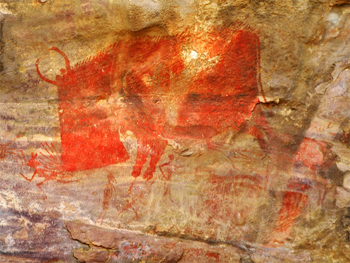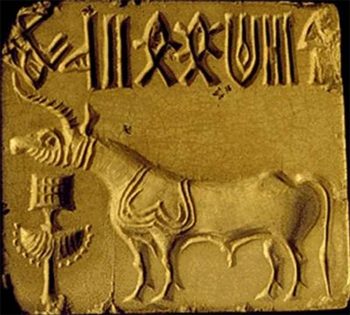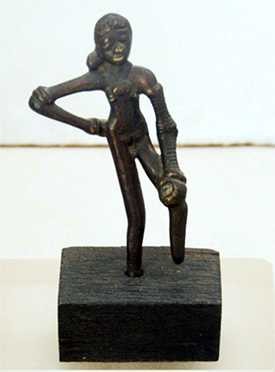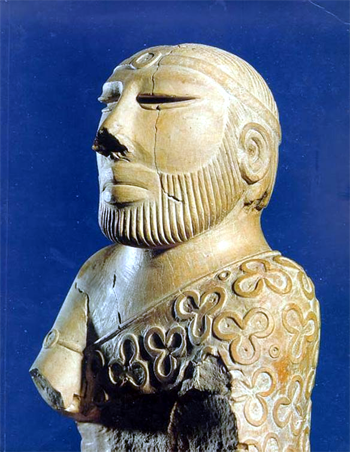Nov 16, 2025
Nov 16, 2025
According to Partha Mitter, “Art generally means sculpture and painting, and often includes architecture, but human artifacts may embrace a wider category of material remains that include the decorative and minor arts, such as jewelry, pottery, metal and wooden utensils and even toys.” It is here, in the absence of much concrete architecture and built remains, that the artefacts of the Indus Valley Civilization or the Harappan culture are of interest as art, and it is in this way that we will study them.
The art of the earliest people in South Asia is of interest, this ranges from cave paintings (such as at Bhimbetka), Neolithic pottery glazed with patterns and decorations, terracotta figurines, cast bronze statuettes, seals and various figures ranging from priest figures to children’s’ toys. However, what is also important is to construct an overview of the Indus Valley culture, as the artifacts from here fall into distinct periods – cultural or temporal.
 Scholars construct four distinct periods in the Indus Valley timeline. The Neolithic period (when food production first became predominant) is from 7000-5500 BC, the Regionalization phase is from 5500-2600 BC, and the emergence of the Indus Valley Culture as a specific civilization as such is from 2600-1900 BC. This is also been called the Integration Era which sees towns and urban centers beginning to form the hub of civilization. Also noted for the use and dissemination of writing, the Integration Era in the Indus Valley Culture saw the production of seals and other associated artifacts. The final era is the so-called Localization Era (1900-1300 BC) which saw both the beginning of the eventual breakup of the Harappan culture, as well as its final concentration into towns and cities.
Scholars construct four distinct periods in the Indus Valley timeline. The Neolithic period (when food production first became predominant) is from 7000-5500 BC, the Regionalization phase is from 5500-2600 BC, and the emergence of the Indus Valley Culture as a specific civilization as such is from 2600-1900 BC. This is also been called the Integration Era which sees towns and urban centers beginning to form the hub of civilization. Also noted for the use and dissemination of writing, the Integration Era in the Indus Valley Culture saw the production of seals and other associated artifacts. The final era is the so-called Localization Era (1900-1300 BC) which saw both the beginning of the eventual breakup of the Harappan culture, as well as its final concentration into towns and cities.
When we consider the major artifacts of this period, we find that there are four major types to consider:
Seals
Soapstone or steatite seals are amongst the most numerous, and according to historians, among the most enigmatic and powerful, artifacts of the Indus Valley Civilization. They are fairly homogenous in their size and shape, and range from ¼ inches to 1 inch square, with a pierced hole in the back to accommodate a string to hang from. Although the carvings and inscriptions on the seals remain under study, it is fair to say that the seals were for personal identification rather than for religious or other symbolic purposes. It is possible that these seals were used for trade and identification, which seems to be the most plausible use for artefacts of this nature. The motifs on the seals range from human depictions to those of animals, though the depiction of religious symbols is also likely, considering the number of forms which have multiple heads, arms or other parts of the anatomy.
 Amongst the most famous seals is that of a humped Brahmani bull, that depicting a one-horned creature (most likely a unicorn), and the so-called Pashupati seal, which shows a hermit-like figure in yogic pose surrounded by figures of animals and vegetation. All these seals, when finished, would have been covered with a fine alkali coating intended for protection and to produce a glossy finish.
Amongst the most famous seals is that of a humped Brahmani bull, that depicting a one-horned creature (most likely a unicorn), and the so-called Pashupati seal, which shows a hermit-like figure in yogic pose surrounded by figures of animals and vegetation. All these seals, when finished, would have been covered with a fine alkali coating intended for protection and to produce a glossy finish.
Terracotta Figures
Other produced artifacts at the Indus Valley civilization are small figures and statuettes in terracotta. These figurines range in size from just a few inches high to over a foot (12”). Several of these figurines have been found, and consist of objects such as wheeled carts, cots, stylized female figures with exaggerated breasts and pudenda, with accessories such as necklaces and other ornaments. It is likely that wooden parts needed, for example, to make the wheeled carts work have not survived the ages.
Amongst the most famous of these figurines is that of a mother deity or mother goddess, and is widely considered to represent ideals or abstract concepts of female fertility, thus also indicating that the Harappan culture knew and was able to put into concrete form abstract notions of worship and godhood.
Bronze Dancing Girl, Mohenjodaro
 Amongst the most riveting pieces of art from the Indus Valley Civilization is the bronze figurine of a dancing girl, excavated from a Harappan house in 1926. The statue is that of a young woman, standing upright, with her head tilted back and her knee bent at an angle. Despite the absence of flesh or any carving that approximates correct human proportions, this statuette is remarkable for its dynamism of pose and the cultural proclivities that it demonstrates. The statuette has her right arm bent and hand placed behind the hip, while the left rests on the thigh of the left leg. A number of bangles, necklaces and pendants decorate the figures neck and arms, and the hair is coiled into a loose bun. Whether the figure actually represents a dancing girl is a matter of some conjecture, though certainly the restrained movement inherent in the pose, the provocative nature of the figure, and the numerous adornments indicate this profession.
Amongst the most riveting pieces of art from the Indus Valley Civilization is the bronze figurine of a dancing girl, excavated from a Harappan house in 1926. The statue is that of a young woman, standing upright, with her head tilted back and her knee bent at an angle. Despite the absence of flesh or any carving that approximates correct human proportions, this statuette is remarkable for its dynamism of pose and the cultural proclivities that it demonstrates. The statuette has her right arm bent and hand placed behind the hip, while the left rests on the thigh of the left leg. A number of bangles, necklaces and pendants decorate the figures neck and arms, and the hair is coiled into a loose bun. Whether the figure actually represents a dancing girl is a matter of some conjecture, though certainly the restrained movement inherent in the pose, the provocative nature of the figure, and the numerous adornments indicate this profession.
Priest Figure, Mohenjodaro
 According to Possehl, “…excepting perhaps the Mahayogi seal…nothing has come to symbolize the Indus Valley Civilization better than the so-called priest-king from Mohenjo-daro.” This piece, dating from the Late Indus Civilization, is 18 centimeters in height and wrapped in a robe-like cloth from its left shoulder to under its right arm, and is covered in a trefoil design common to other objects from the region. The trefoil design also has circles breaking its rhythm.
According to Possehl, “…excepting perhaps the Mahayogi seal…nothing has come to symbolize the Indus Valley Civilization better than the so-called priest-king from Mohenjo-daro.” This piece, dating from the Late Indus Civilization, is 18 centimeters in height and wrapped in a robe-like cloth from its left shoulder to under its right arm, and is covered in a trefoil design common to other objects from the region. The trefoil design also has circles breaking its rhythm.
The Indus Script
Very few objects in archaeological history are as intriguing as the Indus script, found on seals and other objects. This script remains one of the few ancient writings that is yet to be deciphered satisfactorily by historians. Once again, according to Possehl (p.127), the writing system of the Indus is not based on economics, and relatively little is known about it. At best historians have conjectured that the script on Harappan seals seems to be indicating names, titles and places. There is a total lack of any coherent literature as such, and what messages exist are engraved on seal surfaces, scratched out on terracotta ornaments, and the like. No writing, for example, has been found on material like paper, papyrus, bark and so on which might indicate the emergence of a literature of sorts amongst the Indus Valley people.
To conclude, what classifies objects from the Indus Valley as art? If art is creating form and content that appeals to, and stimulates the imagination in an aesthetically pleasing way, then certainly the various artifacts from the Harappan culture imitate this concept in such as way as to classify them as ‘art’. While all the objects found from the Indus Valley do have a utilitarian purpose, yet it is in their details that art can be found – in the proportions of a seal, in the pose of a human figure, in the poise of a priest figure, and in the symmetry and fluidity of writing. The Indus Valley made significant steps in this direction, moves that were eclipsed by Aryan cultures that were to subsequently follow.
07-Jul-2010
More by : Ashish Nangia

|
its very interesting knowledgeable and i like ittttttttttttttttttttt |